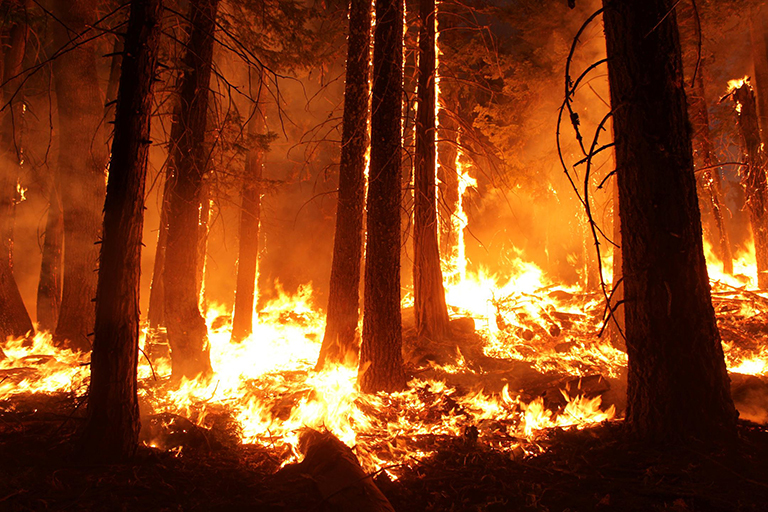Last year turned out to be a year of penance. Several challenges came to the face of the thriving humans including several reports of raging bushfires in Australia, USA’s California and India’s Uttarakhand, which were equally disturbing.
It brought the entire world to not disregard climate’s urgencies in vain and grabbed its attention on these climate change-induced environmental disasters.
This year, a similar fate came to the way of our mountains and now fires raging uncontrollably in the East Indian state of Odisha, where forests have been fighting this war for over ten days.
Unprecedented Forest fires destroy the absolute livelihoods: killing biodiversity, pushing migration, occurrence of pests or diseases and razing forest lands. At times, fires can only let live a few plant species resistant enough, this may carve the extinction of other indigenous species.
It has been observed that fire seasons and the intensity involved is increasing year-by-year due to global warming. High temperature, wind speed and its direction, moisture level in soil and atmosphere and duration of dry spells can thus accentuate the forest fires and in turn, fire influences the climate system by releasing loads of carbon into the atmosphere.
It releases billions of tons of CO2 directly into the atmosphere in one go, the CO2 that otherwise remain stored in the organic matter and is released gradually. Consequently, hundreds of thousands of people become prone to illnesses caused by such exposure to smoke from forest fires.
Indian forests in past have experienced fires but it has been aggravated with rising human-cattle population and increased cattle grazing, shifting cultivation and increased extraction of forest resources by individuals as well as communities.
Here are a few findings by FSI regarding forest fires:
It has recorded 5,291 forest fires in Odisha between February 22 and March 1, 2021 and nearly 233 active large forest fire events within Odisha.
In total, the cumulated number of large forest fires detected across Odisha alone on a day accounted for 1/4th of the total large forest fires recorded across the country on the day.
More than 40 fires were detected in Similipal Tiger reserve located in Mayurbhanj district.
Approximately one-third of the reserve forest area has been destroyed by the fire and about 30 reserve forests within the Similipal Wildlife Sanctuary remain affected.
Telangana has recorded the second-highest fires in the country at 1,527 during the same period, followed by Madhya Pradesh (1,507) and Andhra Pradesh (1,292).
Reasons for such unwelcomed fires:
One of the prominent reasons is the early onset of summer this year and a prolonged dry spell. This leads to increased fuel load like dry twigs and branches having the propensity to burn.
During the period, observed is the 72% rain deficiency in the country. Total rainfall over the country as a whole for the month was 7.6mm, 68% lesser than the expected Long Period Average (LPA) of 23.5mm making it the sixth lowest since 1901.
The impending ecological crisis, including climate change, over dependence on land, increased deforestation, diminishing of natural forest defenses, illegal mining and lack of safety measures undertaken by the government.
At times, anthropogenic activities are involved in the indiscriminate starting of forest fires.
Globally, the duration of fire season has increased by nearly 19 percent between 1979 and 2013. India reports most of its fires during summer season those have greatly increased in number and extent between 2014 and 2018.
In particular case of Odisha, collection of mahua flowers for medicinal uses and kendu leaves for making bidis, practicing shifting cultivation were apparently the drivers of such fires.
Based on the government inventory records, 54.40% of forests in India are exposed to occasional fires, 7.49% to moderately frequent fires and 2.405 to high incidence levels while 35.71% of India’s forests have not yet been exposed to fires of any real significance but are potential enough to burn.
Fire data gets collected using two satellites:
Suomi National Polar-orbiting Partnership (SNPP)
Moderate Resolution Imaging Spectroradiometer(MODIS)
India against Forest Fires:
National Action Plan on Forest Fires (NAPFF): launched in 2018 to minimize forest fires by engaging the forest fringe communities in protection of their surroundings, incentivizing them to work with the State Forest Departments and enhance capabilities of forest personnel and institutions in fighting fires and swift recovery from damages by fire incidents.
The Forest Fire Prevention and Management Scheme (FPM) is the only centrally funded program specifically dedicated to assist the states in dealing with forest fires. Nodal forest officers appointed to keep a check on fires.
It is said that fire is a good servant but a terrible master. No one has an absolute control over the man’s best friend. Thereby its mitigation is way better than its control.

